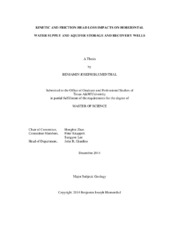| dc.description.abstract | Groundwater wells can have extreme pressure buildup when injecting and extreme pressure drawdown when extracting. Greater wellbore contact with the aquifer minimizes pressure buildup and pressure drawdown. Aquifers are usually much more laterally extensive than vertically thick. Therefore, horizontal wells can be longer than vertical wells thus increasing aquifer contact and minimizing pressure issues. The length and therefore the effectiveness of horizontal wells are limited by two factors, either well construction or intra-wellbore head loss.
Currently no analytical groundwater model rigorously accounts for intra-wellbore kinetic and friction head loss. We have developed a semi-analytical, intra-wellbore head loss model dynamically linked to an aquifer. This model is the first of its kind in the groundwater literature. We also derived several new boundary condition solutions that are rapidly convergent at all times. These new aquifer solutions do not require approximation or pressure pulse tracking.
We verified our intra-wellbore head loss model against MODFLOW-CFP and found matches of three significant figures. We then completed 360 simulations to investigate intra-wellbore head loss. We found that only when aquifer drawdown was small will intra-wellbore head loss be relatively important. We found intra-wellbore head loss is relatively important only in extreme scenarios. We also found that kinetic head loss was greater than friction head loss if the well was less than 10m – 100m long.
To investigate well construction limitations, we developed an equation for the optimal slant rig entry angle, a drilling forces model, and a well construction cost model. We then collected well cost data and combined these models to make 60 well cost estimates. We found the relative cost of a horizontal well, compared to a vertical well, decreases with depth.
We then used our aquifer model to investigate the benefits of horizontal wells. We found several parameters that increase the number of vertical wells replaced by a horizontal well. These parameters include less time since pumping began, nearby recharge boundaries, vertical fractures, lower permeability, higher specific storativity, and thinner aquifers. Comparing horizontal well benefit with cost, we found that horizontal wells may or may not be economically advantageous depending on site specific conditions. | en |



